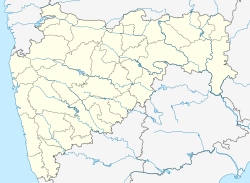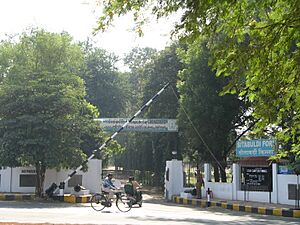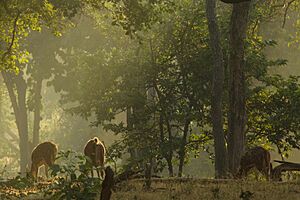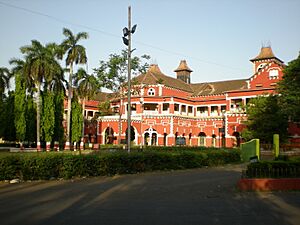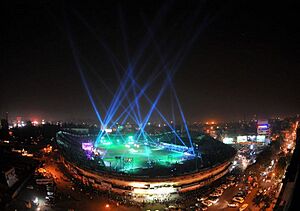Nagpur facts for kids
Quick facts for kids
Nagpur
|
|
|---|---|
|
From top, left to right : Deekshabhoomi, General Post Office, BAPS Swaminarayan Temple, Vidhan Bhavan, Nagpur, Zero Mile Stone (Nagpur), Downtown Skyline of Nagpur, Vidarbha Cricket Association Stadium and Nagpur Metro
|
|
| Nickname(s):
Orange city
The heart of India Tiger capital of India Tiger gateway of India |
|
| Country | |
| State | |
| Region | Vidarbha |
| District | Nagpur |
| Founded | 1702 |
| Founded by | Bakht Buland Shah |
| Named for | Nag River |
| Government | |
| • Type | Mayor–Council |
| • Body |
|
| Area | |
| • Nagpur Metro | 393.50 km2 (151.93 sq mi) |
| • Nagpur City | 227.36 km2 (87.78 sq mi) |
| Elevation | 310 m (1,020 ft) |
| Population
(2011)
|
|
| • Nagpur Metro | 2,405,665 |
| • Estimate
(2021)
|
3,127,000 |
| • Rank | India: 13th Maharashtra : 3rd Vidarbha: 1st |
| • Density | 6,113.51/km2 (15,833.91/sq mi) |
| • Metro | 2,497,870 |
| • Metro rank | 13th |
| Demonym(s) | Nagpurkar, Nagpurians |
| Time zone | UTC+5:30 (IST) |
| Pin code(s) |
440 001 – 440 037
|
| Telephone code | +91-712 |
| Vehicle registration | MH-31 (Nagpur West) MH-49 (Nagpur East) MH-40 (Nagpur Rural) |
| Nominal GDP (Nagpur district) | ₹181,665 crore (US$31 billion) (2022-23) |
| GDP Per Capita | ₹296,607 (US$5,000) |
| Budget (Nagpur City) | ₹5,565.07 crore (US$950 million) |
| Sex ratio | 951 ♀ / 1000 ♂ |
| HDI | |
| Official language | Marathi |
| UN/LOCODE | IN NAG |
| Literacy | 89.52% |
| Airport | Dr. Babasaheb Ambedkar International Airport |
| Rapid transit system | Nagpur Metro |
Nagpur is a big city in the Indian state of Maharashtra. It's the third-largest city there, after Mumbai and Pune. People often call it the "heart of India" because it's right in the middle of the country. It's also the biggest city in central India.
Nagpur is famous for its oranges, which is why it's also known as the "Orange City." It's a very important place for trading these fruits. The city is also called the Tiger Capital of India because many tiger reserves are nearby.
In 2013, a survey said Nagpur was one of the best cities in India to live in. It scored high for being livable, green, having good public transport, and healthcare. It was also named a top city for new ideas and good practices in cleanliness surveys in 2018. Nagpur is also considered one of the safest cities for women in India.
The city was started in 1702 by a Gond King named Bakht Buland Shah. Later, it became part of the Maratha Empire. The British East India Company took over in the 1800s and made Nagpur the capital of the Central Provinces and Berar. After India became independent, Nagpur became the second capital of Maharashtra.
Contents
- What's in a Name? The Story of Nagpur's Name
- A Look Back: Nagpur's History
- Nagpur's Location and Weather
- People of Nagpur: Demographics
- How Nagpur is Governed
- Nagpur's Economy: A Growing Hub
- Nagpur's Culture and Traditions
- Exploring Nagpur: Tourism
- Getting Around Nagpur: Transport
- Learning in Nagpur: Education
- News and Media in Nagpur
- Sports in Nagpur
- Images for kids
- See also
What's in a Name? The Story of Nagpur's Name
Nagpur gets its name from the Nag River, which flows through the city. The older part of Nagpur, called 'Mahal', is on the north side of this river. The word Pur means "city" in many Indian languages. So, Nagpur means "City of the Nag River."
Some people believe the city and river were named after the 'Nags', who were an ancient group of people. During the time of British rule, the city's name was spelled and said as "Nagpore."
A Look Back: Nagpur's History
How Nagpur Began
People have lived around Nagpur for about 3000 years! Old burial sites show that a very ancient culture lived here. The name "Nagpur" was first seen in a copper plate from the 10th century.
Around the 3rd and 4th centuries, the Vakataka Dynasty ruled this area. Their king, Prithvisena I, even moved his capital to Nagardhan, not far from Nagpur. After them, other Hindu kingdoms like the Badami Chalukyas and Rashtrakutas ruled.
In the 17th century, the Mughal Empire took control. But the local area was still managed by the Gond kingdom of Deogarh. In the 18th century, the Bhonsle family from the Maratha Empire set up their kingdom in Nagpur.
Nagpur in Modern Times
Bakht Buland Shah officially founded Nagpur in 1702. He brought many Marathi farmers to the area to help the economy grow. After him, Chand Sultan made Nagpur his capital and built walls around the town.
When Chand Sultan died, his wife asked the Maratha leader Raghoji Bhosale for help. Raghoji Bhosale then became the ruler of Nagpur and expanded its territories.
Nagpur faced some attacks in 1765 and 1811, but it kept growing. In 1803, the British fought against the Marathas in the Second Anglo-Maratha War and won. Later, in 1817, the British defeated the Marathas again in the Third Anglo-Maratha War at Sitabuldi, which is in Nagpur today. This battle led to the British taking control of the city.
From 1853 to 1903, Nagpur was the capital of the Central Provinces and Berar under British rule. The arrival of the railway in 1867 helped Nagpur become a big trading center. The Tata group even started its first textile mill here in 1877.
In 1920, the non-co-operation movement against British rule was launched in Nagpur. The city also saw some Hindu-Muslim riots in 1923. This led to K. B. Hedgewar founding the Rashtriya Swayamsevak Sangh (RSS) in Nagpur in 1925.
After India Became Independent
After India gained independence in 1947, Nagpur became the capital of the state of Madhya Pradesh. But in 1956, when states were reorganized based on languages, Nagpur became part of the state of Bombay. This state later split into Maharashtra and Gujarat in 1960. Nagpur then became the second capital of Maharashtra.
On October 14, 1956, B. R. Ambedkar and many of his followers converted to Buddhism in Nagpur. This started the Dalit Buddhist movement. In 1994, Nagpur saw a sad event called the 1994 Gowari stampede, where many people died during a protest.
In 2002, Nagpur celebrated 300 years since its founding with a big event.
Nagpur's Location and Weather
Where is Nagpur?
Nagpur is right in the middle of India! It's close to the exact center of the country. There's even a special Zero Mile Stone in the city. The British used this stone to measure all distances across India.
The city sits on the Deccan plateau, about 310.5 meters above sea level. The land is mostly covered with soil from the Kanhan River. Nagpur has many natural and man-made lakes. The biggest natural lake is Ambazari Lake. Other lakes include Gorewada Lake and Telankhedi lake. The Nag river helps drain the city. Nagpur is also known for its many trees and green spaces. In 2010, it was named the second greenest city in India.
Nagpur's Climate: Hot Summers and Mild Winters
Nagpur has a tropical wet and dry climate. This means it's dry for most of the year. Summers are very hot, from March to June, with May being the hottest month. Temperatures can get very high.
Winter lasts from November to February. During this time, temperatures can drop to about 10 °C (50 °F). Nagpur also gets a lot of rain during the monsoon season, especially in July. The city has been working to deal with heat waves, especially in May.
People of Nagpur: Demographics
How Many People Live Here?
| Historical population | ||
|---|---|---|
| Year | Pop. | ±% |
| 1981 | 1,219,500 | — |
| 1991 | 1,664,000 | +36.4% |
| 2001 | 2,052,066 | +23.3% |
| 2011 | 2,405,665 | +17.2% |
| Source: Census of India | ||
According to the 2011 census, Nagpur city had a population of over 2.4 million people. There were slightly more males than females. About 10% of the population were children aged 0-6. Many people in Nagpur live in slums, which are home to about 35% of the city's population. The average literacy rate in Nagpur is very high, at about 91.92%. This means most people can read and write.
| Year | Male | Female | Total Population | Change |
|---|---|---|---|---|
| 2001 | 1059765 | 992301 | 2052066 | - |
| 2011 | 1225405 | 1180260 | 2405665 | 17.231 |
Religions in Nagpur
| Religion in Nagpur City (2011) | ||||
|---|---|---|---|---|
| Religion | Percent | |||
| Hinduism | 69.46% | |||
| Buddhism | 15.57% | |||
| Islam | 11.95% | |||
| Others | 1.88% | |||
| Christianity | 1.15% | |||
Most people in Nagpur follow Hinduism, making up about 69.46% of the population. Buddhism is the second most popular religion, with 15.57% of people following it. Nagpur is very important for Buddhists because of Deekshabhoomi. Islam is followed by about 11.95% of the population. Other religions like Christianity, Jainism, and Sikhism are also present in smaller numbers.
Languages Spoken in Nagpur
Marathi is the most common language spoken in Nagpur, by over 60% of the people. Hindi is the second most spoken language, followed by Urdu. You can also hear other languages like Chhattisgarhi, Sindhi, Gujarati, and Punjabi in the city.
How Nagpur is Governed
Nagpur used to be the capital of the Central Provinces and Berar for 100 years. When states were reorganized in 1956, Nagpur became part of Maharashtra. To make sure Nagpur still had an important role, a special agreement called the Nagpur Pact was signed. Because of this pact, one session of the state assembly and legislative council is held in Nagpur every year, usually in winter.
The city has a district court and a branch of the Bombay High Court. Nagpur is divided into six areas for voting in the state assembly. These areas are part of the Nagpur Lok Sabha constituency for national elections.
City Services and Utilities
Many services in Nagpur, like water supply and garbage collection, used to be managed by the city government. But since 2008, some of these services have been taken over by private companies. For example, a company called Orange City Water Private Limited (OCW) now manages the city's water supply.
Garbage collection is handled by AG Enviro Infra Project Pvt Ltd and BVG India. Electricity used to be managed by MSEB, but now it's MSEDCL. Nagpur also has nine fire stations. The postal service, India Post, has many offices across the city.
Military Presence in Nagpur
Nagpur is an important city for India's armed forces. The Maintenance Command of the Indian Air Force has its main office here. This command handles the repair and upkeep of all aircraft and helicopters.
There are also ordnance factories and a staff college for them in the city. The historic Sitabuldi Fort is managed by the Indian Army. People can visit the fort on special national holidays.
The Kamptee Cantonment, a military base, is still active. It has the only Officers Training Academy for the National Cadets Corps. It's also home to the Brigade of the Guards, a very old and respected army regiment. This regiment is the only one in the Indian Army to have won two Param Veer Chakra awards, which are the highest awards for bravery in wartime.
Nagpur's Economy: A Growing Hub
Nagpur is becoming a very important city for business and trade. Its economy was estimated to be around ₹181,665 crore in 2022-23. This makes it the biggest economic center in central India. The city's economy has grown a lot, especially after a period when it was not as focused on by the state government.
Nagpur is also important for banking. The Reserve Bank of India has a regional office here, which opened in 1956. One of its branches even holds all of India's gold reserves! Sitabuldi market is a very busy shopping area in the heart of the city.
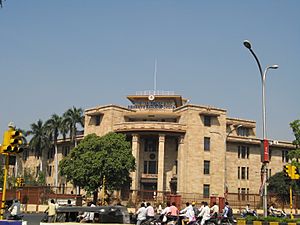
Many well-known Indian companies started in Nagpur. These include the ice-cream maker Dinshaws, the dry food company Haldiram's, and the Ayurvedic products company Vicco.
For centuries, Nagpur has been famous for its oranges, earning it the nickname "Orange City." It's the biggest market for oranges in India. Oranges from Nagpur are sold all over the country and even exported to other countries. The city is also known for its cotton and silk weaving.
Nagpur and the surrounding Vidarbha region are very important for power generation. There are large thermal power stations near Nagpur, like Koradi and Khaparkheda.
The Multi-modal International Hub Airport at Nagpur (MIHAN) is a big project. It's developing the Dr. Babasaheb Ambedkar International Airport and creating a large business hub around it. Many big technology companies like TCS, Tech Mahindra, and HCL have offices in Nagpur's IT parks.
Companies like Tata Advanced Systems and Dassault Reliance Aerospace Limited also have manufacturing facilities in MIHAN. Nagpur is also becoming a major logistics hub, with several inland container depots.
Because the region has many natural resources, mining is a big activity. Several government mining organizations, like Western Coalfields Limited, are based in Nagpur.
Nagpur's Culture and Traditions
Cultural Events and Literature
Nagpur is a city where people from many different Indian states and religions live together peacefully. The city hosts many cultural events throughout the year. Groups like Vidarbha Sahitya Sangh work to promote the Marathi language.
The South-Central Zone Cultural Centre also organizes events like the Orange City Craft Mela and Folk Dance Festival. The Government of Maharashtra holds a week-long Kalidas Festival, featuring music and dance performances by famous artists. The city also hosts the Orange City International Film Festival every year.
The Nagpur Central Museum (started in 1863) has collections mainly from the Vidarbha region. Nagpur has a rich history of painting, supported by the old Bhonsale rulers.
Religious Places and Festivals in Nagpur
Deekshabhoomi is a very important place for Buddhists. It's the largest hollow stupa (a dome-shaped monument) in the world. Every year on Vijayadashami (Dussehra), many followers of Ambedkar visit Deekshabhoomi. This marks the day in 1956 when Ambedkar and his followers converted to Buddhism. The Maharashtra Government has given it 'A' grade tourist status.
Jainism also has a strong presence in Nagpur, with nearly 30 Jain temples.
The most famous Hindu temple in Nagpur is Tekdi Ganesh Mandir. It's believed to be a Swayambhu (self-manifested) temple. Other important Hindu temples include Sri Poddareshwar Ram Mandir and Shri Mahalaxmi Devi temple of Koradi.
People in Nagpur celebrate many religious festivals throughout the year. Ram Navami is celebrated with a procession of floats. Other festivals like Dhamma Chakra Pravartan Din, Vijayadashami, Eid E Milad, Guru Nanak Jayanti, Mahavir Jayanti, Durga Puja, Ganesh Chaturthi, and Moharram are also celebrated with enthusiasm. Like the rest of India, major Hindu festivals like Diwali, Holi, and Dussera are big celebrations.
Nagpur has a large Muslim population. Important places of worship include the Jama Masjid-Mominpura. The most famous shrine is the dargah of Tajuddin Muhammad Badruddin at Tajabad. An annual festival called Urs is celebrated there with great joy.
There are also many churches, like the St. Francis De Sales Cathedral. South Indian temples, such as Sarveshwara Devalayam and Balaji temple, are also found in Nagpur.
The Marbat Festival is a unique festival for Nagpur. It's held every year after the bullock festival of 'Pola'. This tradition started in 1880. People carry idols called 'kali' (black) and 'pivli' (yellow) Marbats, along with 'badgyas' (mascots) that represent bad things.
The Parsi community in Nagpur celebrates the Parsi New Year at their Agiary (Dar-e-Meher).
Delicious Food: Nagpur's Cuisine
The Vidharbha region has its own special food called Varhadi cuisine or Saoji cuisine. Saoji food is known for being very spicy. It uses special spices like black pepper, dry coriander, and poppy seeds. Non-vegetarian dishes, especially chicken and mutton, are very popular in Saoji restaurants in Nagpur. Even famous chef Sanjeev Kapoor has featured Saoji mutton on his TV shows.
Nagpur is also famous for its oranges, which are used to make many drinks and sweets. Santra Barfi, a sweet made from oranges, is a local favorite. Mominpura, a Muslim area, is known for its Mughal dishes and Biryani. The city is also famous for a rare black chicken called Kadaknath Chicken, cooked in the Varhadi style.
Another famous Nagpur food is tarri poha, a type of flattened rice served with a spicy chickpea curry. Samosas are also very popular.
Exploring Nagpur: Tourism
Tiger Reserves Near Nagpur
Nagpur is surrounded by many tiger reserves, which is why it's called the Tiger Capital of India.
- Pench Tiger Reserve is about 100 km away.
- Tadoba National Park is about 141 km south of the city.
- Other nearby reserves include Umred Karhandla Wildlife Sanctuary, Bor Wildlife Sanctuary, Navegaon National Park, Melghat Tiger Reserve, and Kanha Tiger Reserve.
The city itself has reserved forest areas at Seminary Hills and Gorewada.
Zoos, Gardens, and Lakes
Maharajbagh zoo is in the city center and has many different animals. The Balasaheb Thackeray Gorewada International Zoological Park is a new international zoo near Gorewada Lake. It offers wildlife safaris.
Nagpur has several natural and man-made lakes. Khindsi Lake, Ambazari Lake, and Gorewada Lake are natural. Futala Lake, Shukrawari Lake, and Sonegaon lake are man-made. Futala Lake is being developed to have one of the world's largest musical fountains.
The city also has many beautiful gardens, such as Ambazari Garden, Telankhedi Garden, and the Japanese Garden. There are also water parks for fun.
The government is planning to create Maharashtra's first "Divyang Park" in Nagpur. This special park will have facilities for people with disabilities, including sensory gardens and skill training areas.
Important Religious Sites
Nagpur has many religious places for different faiths. Deekshabhoomi and Dragon Palace are very important for Buddhists. Dragon Palace Temple is about 15 km from the city. It also has a Vipassana meditation center.
Other notable religious places include:
- Ramtek Fort Temple: A temple built inside a fort, about 55 km from Nagpur.
- Adasa Ganpati Temple: One of the eight Ashta Vinayaks in Vidarbha.
- Baba Tajjuddin Dargah: A famous shrine for Muslims.
- Shree Ganesh Mandir Tekdi: A very old and important Hindu temple near the railway station.
- Sai Baba Mandir, Swaminarayan Temple, and Koradi Temple.
- Many South Indian temples like Sarveshwara Devalayam and Balaji Temple.
- All Saints Cathedral and Gurudwara Guru Nanak Darbar.
Museums and Science Centers
Nagpur has museums like the Nagpur Central Museum and the Narrow Gauge Rail Museum. The Raman Science Centre is a top science center in Central India. It has many interactive exhibits, a planetarium, and a unique "Science on a Sphere" display.
Getting Around Nagpur: Transport
Railways in Nagpur
Trains first came to Nagpur in 1867. Today, Nagpur is a very busy railway hub. Over 250 trains stop at Nagpur railway station every day. This includes many types of trains like Express, Duronto, and Vande Bharat. About 160,000 passengers use the station daily.
Nagpur Junction is one of India's oldest and busiest stations. Besides Nagpur Junction, Ajni railway station and Itwari railway station are also important. Nagpur is unique because it has two railway divisional headquarters: for the Central Railway and South East Central Railway zones.
Nagpur Metro Rail
Nagpur Metro is the city's modern train system. It started running on March 8, 2019. The first phase was fully opened in December 2022. On January 1, 2023, the Nagpur Metro set a record with over 200,000 passengers in one day! The second phase of construction has also begun.
Roadways in Nagpur
Nagpur is a major junction for roads. Two of India's main national highways, NH 44 (Srinagar-Kanyakumari) and NH 53 (Mumbai-Kolkata), pass through the city. NH 47 also connects Nagpur to Gujarat. Nagpur is also part of two Asian Highways.
The Maharashtra State Road Transport Corporation (MSRTC) provides affordable bus services for travel within the city, state, and to other states. It has two main bus stations in Nagpur.
The Nagpur Municipal Corporation runs the city's local bus service, called Aapli Bus (your bus). They have over 480 buses that cover 123 routes daily. These buses run on diesel, ethanol, and CNG. Nagpur was the first city in India to use ethanol-powered buses in 2014.
Nagpur is now directly connected to Shirdi by the Mumbai–Nagpur Expressway. This expressway will soon connect Nagpur directly to Mumbai, the state capital. Other new expressways are also planned to link Nagpur to cities like Goa, Hyderabad, and Indore.
For local travel, people also use Autorickshaws and private taxis like Ola Cabs and Uber.
Air Travel in Nagpur
Dr. Babasaheb Ambedkar International Airport is Nagpur's airport. It's operated by Mihan India Private Limited (MIPL).
Nagpur's Air Traffic Control (ATC) is one of the busiest in India, with over 300 flights flying over the city every day. In 2005, Nagpur's airport became an international airport and was renamed Dr. Babasaheb Ambedkar International Airport.
The airport has won awards for its services. Nagpur was the first airport in India to use the INDRA system and the ADS-B system. It was also the first airport in the world to get an ISO 27000 certificate for its air navigation services.
The Indian government has chosen Nagpur Airport as a safe place for diverted flights and emergency landings. This is because it has excellent fire fighting equipment, modern air traffic control, and good hospitals and hotels nearby.
The airport can handle 1 million passengers a year, but it often handles more. There are plans to expand and improve the airport, and the government has suggested privatizing it.
Learning in Nagpur: Education
Nagpur is a major center for education in Central India.
The city has two types of schools: those run by the NMC (government schools) and private schools. Students usually study for 10 years in school, followed by 2 years of higher secondary education. After that, they can go to college for a general degree or a professional degree like engineering or medicine. Schools follow different education boards, such as the Maharashtra State Board, Central Board of Secondary Education (CBSE), or Indian Certificate of Secondary Education (ICSE).
To get into professional colleges, students usually need to pass entrance exams like MHT-CET or JEE (Main).
Nagpur has five state universities:
- Rashtrasant Tukadoji Maharaj Nagpur University (founded in 1923, one of the oldest in India)
- Maharashtra Animal and Fishery Sciences University
- Kavikulaguru Kalidas Sanskrit University
- Maharashtra National Law University
- Laxminarayan Innovation Technological University
There is also one private university, Ramdeobaba University (RBU).
Nagpur has five government medical colleges, including Government Medical College and All India Institute of Medical Sciences (AIIMS). There is also one private medical college.
Most engineering colleges are connected to Rashtrasant Tukadoji Maharaj Nagpur University. Government Polytechnic, Nagpur (started in 1914) is one of India's oldest polytechnics. Visvesvaraya National Institute of Technology (VNIT) in Nagpur is the only NIT in Maharashtra. The Indian Institute of Information Technology was also set up here in 2016. The National Fire Service College, which trains firefighters, is also in Nagpur.
For law studies, Nagpur has two main law schools: Maharashtra National Law University and the Department of Law at Nagpur University. Many private law colleges also offer legal education.
Nagpur also has two major management institutes: Indian Institute of Management (started in 2015) and Institute of Management Technology. The College of Agriculture, founded in 1906, was one of the first agriculture colleges in the country.
Other important government institutes in Nagpur include:
- National Power Training Institute
- Central Institute for Cotton Research
- National Academy of Direct Taxes
- National Environmental Engineering Research Institute
News and Media in Nagpur
The Hitavada is the most popular English daily newspaper in Central India. It was started in 1911. Other English newspapers available are The Times of India and The Indian Express. Many Marathi newspapers like Lokmat and Sakal, and Hindi newspapers like Nava Bharat and Dainik Bhaskar are also circulated.
All India Radio is the oldest radio broadcaster in the city. It has FM stations like Vividh Bharati and Gyan Vani. Private FM radio channels like Radio City, Red FM, and Radio Mirchi are also popular.
Television broadcasting in Nagpur began in 1982 with Doordarshan, India's public broadcaster. It shows channels like DD National and DD News. Private satellite channels became available in the 1990s. There are also local TV channels like Lord Buddha TV. You can watch TV through cable, satellite, or internet services.
Internet services are widely available in Nagpur. Wi-Fi is available in many educational institutions and some public areas. As of 2023, major mobile networks provide 3G, 4G, and 5G services in the city.
Sports in Nagpur
Nagpur is a big center for cricket. The Vidarbha Cricket Association (VCA) manages cricket activities in the region. Nagpur is one of the few Indian cities with more than one international cricket stadium. The older one is the Vidarbha Cricket Association Ground, and the newer one is the Vidarbha Cricket Association Stadium in Jamtha.
The Vidarbha Cricket Association Stadium can hold 45,000 people. It has hosted major cricket events like the 2011 Cricket World Cup and 2016 ICC World Twenty20. The VCA also has a cricket academy. The Vidarbha cricket team won the Ranji Trophy (a big Indian cricket tournament) two years in a row in 2017-18 and 2018-19.
The Vidarbha Hockey Association manages field hockey in the region and has its own stadium.
The Nagpur District Football Association (NDFA) is in charge of football in Nagpur. It organizes matches for schools and clubs and has its own league. Many football clubs like Indian Friends Football Club and Young Muslim Football Club are popular.
The Nagpur District Badminton Association (NDBA) organizes badminton tournaments. The Nagpur District Table Tennis Association does the same for table tennis. The city also has a big sports complex with an indoor stadium.
The Vivekananda Nagar Indoor Sports Complex is a major indoor arena in Nagpur. It hosts various sports events, concerts, and political gatherings. The city also has many running events for the public.
Images for kids
See also
 In Spanish: Nagpur para niños
In Spanish: Nagpur para niños









